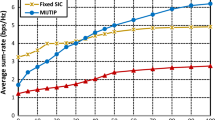Abstract
In order to resolve the crowded radio spectrum of wireless communication systems, visible light communications (VLC), which uses a vast unregulated and free light spectrum, has emerged to be a viable solution. However, duplex communication, user mobility, multi-user access and transmission mechanisms are becoming challenging tasks in VLC network. In this article, we propose a new VLC heterogeneous network (VLC-HetNet) model which merges VLC and radio frequency (RF) network. VLC channel is only used for downlink transmission, while RF channels are served for uplinks in any situation, or for downlinks only without VLC hotspots coverage. New VLC frame, multi-user access mechanism, horizontal and vertical handover protocols are presented to support the VLC-HetNet model, especially for solving the problems at multi-user mobility scenario. Simulation results show improvements in capacity performance of the VLC-HetNet, when compared to RF system. Besides, the average vertical handover number and VLC downlink dwelling time ratio have been analysed.










Similar content being viewed by others
References
Cisco. (2012). Cisco visual networking index: Global Mobile data traffic forecast update, 2011–2016. Whitepaper. www.cisco.com/en/US/solutions/collateral/ns341/ns525/ns537/ns705/ns827/white_paper_c11-520862.html.
National Telecommunications and Information Admission (NTIA). (2003). FCC frequency allocation chart. http://www.Ntia.doc.gov/osmhome/allochrt.pdf.
Kavehrad, M. (2010). Sustainable energy-efficient wireless applications using light. IEEE Communications Magazine, 48(12), 66–73.
Hanzo, L., Haas, H., Imre, S., et al. (2012). Wireless myths, realities, and futures: From 3G/4G to optical and quantum wireless. Proceedings of the IEEE, 100, 1853–1888.
Elgala, H., Mesleh, R., & Haas, H. (2011). Indoor optical wireless communication: Potential and state-of-the-art. IEEE Communications Magazine, 49(9), 56–62.
O’Brien, D., Zeng, L., Le-Minh, H., Faulkner, G., Walewski, J., Randel, S. (2008). Visible light communications: Challenges and possibilities. In IEEE 19th international symposium on personal, indoor and mobile radio communications, New York, USA (pp. 2987–2991).
WPAN Visible Light Communication Study Group. (2008). IEEE Std. 802.15.
Torkenstani, S., Sahuguede, S., Julien-Vergonjanne, A., & Cances, J. (2012). Indoor optical wireless system dedicated to healthcare application in a hospital. IET Communications, 6(5), 541–547.
Delgado, F., Quintana, I., Rufo, J., Rabadan, J., Quintana, A., & Perez-Jimenez, R. (2010). Design and implementation of an ethernet-VLC interface for broadcast transmissions. IEEE Communications Letters, 14(12), 1089–1091.
Ghassemlooy, W., Minh, Z., Rajbhandari, S., Lim, W. (2012). Optimisation of transmission bandwidth for indoor cellular OWC system using a dynamic handover decision-making algorithm. In Proceedings of the 8th symposium on communication systems, networks and digital signal processing, Poznan, Poland, 2012 (CSNDSP 2012) (pp. 1–4).
Hou, J., & O’Brien, D. (2006). Vertical handover decision-making algorithm using fuzzy logic for the integrated radio-and-OW system. IEEE Transactions on Wireless Communications, 5(1), 176–185.
Rahaim, M., Vegni, A., Little, T. (2011). A Hybrid radio frequency and broadcast visible light communication system. In Proceedings of IEEE GLOBECOM, New York, USA (pp. 792–796).
Chowdhury, H., & Katz, M. (2014). Cooperative data download on the move in indoor hybrid (radio-optical) WLAN-VLC hotspot coverage. Transactions on Emerging Telecommunications Technologies, 25(6), 666–677.
Huang, Z. T., & Ji, Y. F. (2013). Design and demonstration of room division multiplexing-based hybrid VLC network. Chinese Optics Letters, 11(6), 060603.
Jungnickel, V., Pohl, V., Noenning, S., & von Helmolt, C. (2002). A physical model for the wireless infrared communication channel. IEEE Journal on Selected Areas in Communications, 20(3), 631–640.
Fath, T., & Haas, H. (2013). Performance comparison of MIMO techniques for optical wireless communications in indoor environments. IEEE Transactions on Communication, 61(2), 733–742.
Bao, X., Yu, G., Dai, J., & Zhu, X. (2015). Li-Fi: Light fidelity—A survey. Wireless Networks, 21, 1879–1889.
O’Brien, D., Turnbull, R., Minh, H., et al. (2012). High-speed optical wireless demonstrators: Conclusions and future directions. Journal of Lightwave Technology, 30(13), 2181–2187.
Singh, S., Andrews, J., & Veciana, G. (2012). Interference shaping for improved quality of experience for real-time video streaming. IEEE Journal on Selected Areas in Communications, 30(7), 1259–1269.
Gross, D., Shortle, J., Thompson, J., & Harris, C. (2008). Fundamentals of queueing theory (4th ed.). Hoboken: Wiley.
Goldsmith, A. (2005). Wireless communications (1st ed.). Cambridge: Cambridge University Press.
Acknowledgments
This work is supported by National Natural Science Foundation of China (Grant Nos. 61502210 and 61571211), the Natural Science Foundation of Jiangsu Province (No. BK20130530), China Postdoctoral Science Foundation (Grant No. 2015M570484), Programs of Senior Talent Foundation of Jiangsu University (No. 11JDG130) and the Open Research Fund of National Mobile Communications Research Laboratory, Southeast University (Nos. 2013D01 and 2013D08).
Author information
Authors and Affiliations
Corresponding author
Rights and permissions
About this article
Cite this article
Bao, X., Dai, J. & Zhu, X. Visible light communications heterogeneous network (VLC-HetNet): new model and protocols for mobile scenario. Wireless Netw 23, 299–309 (2017). https://doi.org/10.1007/s11276-016-1233-z
Published:
Issue Date:
DOI: https://doi.org/10.1007/s11276-016-1233-z




